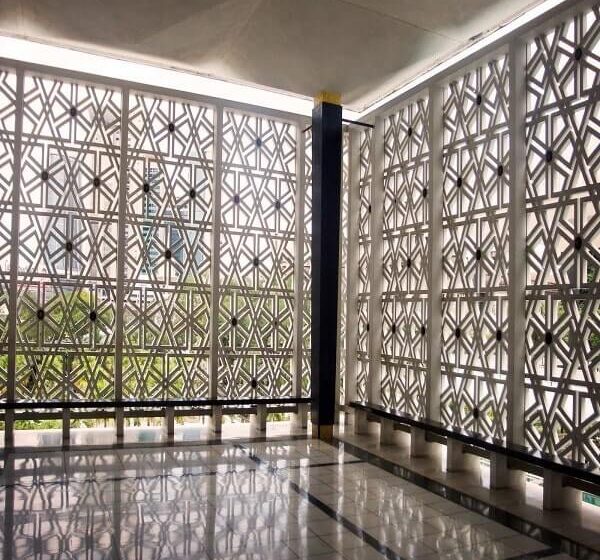Modern architecture continues to evolve as it draws inspiration from cultural heritage, technological advancement, and the pursuit of sustainable aesthetics. One of the most compelling examples of this fusion is the mashrabiya—a traditional element of Middle Eastern architecture reimagined for contemporary structures. Once made primarily of wood and used for ventilation, privacy, and shading, the mashrabiya has found renewed purpose in modern design, now fabricated in materials like steel to meet the needs of current architectural standards.
This transformation has allowed architects to retain the cultural depth of mashrabiya while achieving greater precision, durability, and scalability in application. Designers today seek materials that blend ornamental beauty with structural strength. The introduction of Steel Mashrabiya into architectural projects answers this call by offering a modern reinterpretation of a traditional screen that remains both functional and symbolic. It balances the elegance of patterned geometry with the resilience of metal, making it suitable for contemporary commercial and residential developments alike.
Understanding Mashrabiya
The mashrabiya originated centuries ago in Islamic and Middle Eastern architecture, particularly in regions such as Egypt, the Levant, and the Arabian Peninsula. It traditionally functioned as a projecting oriel window enclosed with intricate latticework made of wood. These screens allowed air to circulate through interiors while providing privacy from the street and controlling sunlight. The mashrabiya was more than just a decorative element—it embodied principles of climate responsiveness, cultural values, and architectural harmony.
As the needs of modern construction began to shift toward materials with greater strength, weather resistance, and sustainability, the mashrabiya evolved. Contemporary versions now use advanced materials and technologies while preserving their iconic aesthetic. Steel has emerged as a leading choice, not only for its structural qualities but also for its ability to be shaped into fine patterns with exceptional detail and consistency.
Why Choose Steel Mashrabiya?
Steel mashrabiya offers a perfect blend of tradition and innovation. Unlike wood, which is prone to decay, warping, or insect damage, steel provides unmatched durability. It withstands harsh weather conditions, maintains structural integrity over time, and requires minimal maintenance. This makes it ideal for large-scale installations on building exteriors, where longevity and resilience are essential.
Moreover, steel’s strength enables designers to create wider spans and taller structures without compromising on the intricate detail that defines mashrabiya designs. This opens up possibilities for more daring and expressive architectural concepts. With finishes such as powder coating or galvanization, steel mashrabiya panels can also resist corrosion, ensuring that both visual and functional performance remain intact for decades.
Design and Customization Possibilities
One of the key reasons for the growing popularity of steel mashrabiya in modern architecture is the vast range of design possibilities it offers. With the advent of laser cutting and CNC fabrication, patterns can now be produced with extreme precision. Whether replicating traditional Islamic geometric motifs or creating new abstract patterns, the design can be fully tailored to reflect the project’s artistic vision.
Designers can select from a wide range of finishes and textures—from matte black to brushed stainless steel or corten rusted surfaces—depending on the building’s design narrative. Thickness, perforation density, and panel size can be customized to control the amount of light and airflow, helping to regulate interior climate while enhancing visual interest.
Moreover, these screens can be used in various ways beyond their original purpose. They can serve as facade cladding, window screens, sliding doors, internal partitions, ceiling panels, and even decorative fencing. Their adaptability allows architects to use a single design language across multiple surfaces, creating a cohesive visual identity throughout the space.
Applications in Modern Architecture
Steel mashrabiya designs are being embraced across a wide range of architectural applications, from private villas and luxury hotels to public institutions and corporate buildings. In residential architecture, mashrabiya panels are often used as privacy screens on balconies or terraces, allowing occupants to enjoy outdoor spaces without compromising their seclusion. They also function as stylish internal partitions that separate living spaces while maintaining an open, airy feel.
In commercial and public spaces, mashrabiya screens take on a bolder role. They can envelop entire building facades, serving as dynamic sun-shading systems that reduce solar heat gain while casting patterned shadows inside. This not only enhances the building’s visual identity but also contributes to energy efficiency. Museums, cultural centers, and educational institutions often use mashrabiya designs to reflect regional identity and heritage through modern means.
Urban designers and landscape architects have also found creative uses for steel mashrabiya. In outdoor settings, they function as sculptural elements, boundary walls, or shade structures in gardens, plazas, and courtyards. Their ability to play with light and shadow adds a kinetic element to the space, constantly changing with the position of the sun.
Sustainability and Performance Benefits
The use of steel mashrabiya in modern architecture also supports environmental sustainability. By acting as passive cooling devices, these screens help reduce reliance on mechanical air conditioning. Their perforated patterns allow for natural ventilation and daylighting, which improves indoor comfort and reduces energy consumption.
Steel is also a recyclable material, making it an environmentally responsible choice. Many steel products used in mashrabiya fabrication contain a significant percentage of recycled content, and at the end of their long life cycle, they can be fully reclaimed and reused. When combined with eco-friendly coatings and low-emission fabrication processes, steel mashrabiya panels contribute positively to green building certifications such as LEED and Estidama.
Additionally, their long lifespan minimizes the need for frequent replacement, reducing material waste and the carbon footprint associated with maintenance and reconstruction. As cities move toward more sustainable and climate-responsive architecture, steel mashrabiya designs offer a compelling solution that blends tradition, beauty, and performance.
Conclusion
The reimagining of mashrabiya in steel form is a testament to how tradition and technology can work in harmony. Steel mashrabiya designs bring a timeless elegance to modern architecture, paying homage to cultural heritage while meeting the practical demands of today’s built environment. Their versatility, strength, and design adaptability make them a favored choice for architects seeking to create spaces that are both beautiful and sustainable.
From facades that breathe to interior partitions that captivate, steel mashrabiya stands as a powerful architectural expression. It symbolizes not just a revival of regional identity, but also the ability of modern materials and techniques to enhance age-old design philosophies. As the architectural world continues to push boundaries, steel mashrabiya will remain a significant element in shaping buildings that are both innovative and rooted in tradition.



